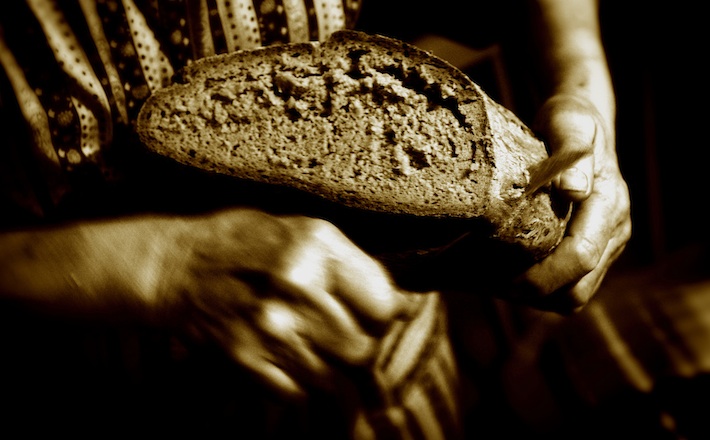Commentary on John 6:24-35
John presents Jesus as manna, the miraculous bread God provided and through which Israel learned to trust God’s word.
The crowd introduces the story of manna, which becomes central to John’s development of Jesus’ identity as “bread of life” in this chapter. They ask Jesus to perform a sign like Moses did when God provided the Israelites with a miraculous food in the desert.
It is ironic that the crowd doesn’t already associate Jesus with Moses. This is part of the same group of people that was present at the beginning of the chapter. By including the details of Jesus going up a mountain at the time of Passover (John 6:3-4) alongside a miraculous meal, John has already given the reader reasons to associate Jesus with Moses from the Exodus story. Even though the crowd acclaimed Jesus as prophet and sought to make him king (John 6:14-15), they seem not to have really understood the significance of what happened in the feeding miracle (John 6:1-14).
Now the crowd seeks Jesus across the sea, asking him for a sign like Moses did (John 6:31). It seems strange for them to say this, since Jesus has just performed a sign like the one they require. Yet their words also confirm what Jesus has said. They have not “seen signs” (John 6:26). That is, they did not understand the meaning of Jesus’ actions in the feeding miracle.
Even though the crowd conveys little understanding, Jesus takes up their request to perform a sign like the manna. He goes on to explain how the manna God gave previously is now available to them. Jesus’ words that follow — really all of John 6:32-58 — interpret the scripture quoted by the crowd, “he gave them bread from heaven to eat” (John 6:31). He begins by interpreting the manna as a story about what God is doing in the present.
It is common to read these verses in John in a way that distances the bread Jesus offers from the manna story. Part of this decision stems from a translation problem. The English, “it was not Moses who gave you the bread from heaven” (John 6:32, New Revised Standard Version) can sound like Jesus is rejecting a false assumption that made Moses rather than God the giver of manna. This seems unlikely, however, because it is implausible that Jewish people of John’s time viewed Moses as the ultimate source of manna.
Instead, Jesus’ words represent a way of interacting with scripture that was common at the time. He says, don’t think of the scripture as saying “Moses gave” the bread, but as “my father gives” it (compare with John 6:32). Jesus defines and slightly alters the terms of the scripture. The cited text in verse 31 stated, “he gave us bread from heaven to eat.” Jesus says, don’t interpret the subject, “he” as Moses, but as God. Furthermore, he changes the verb tense from “gave,” the past tense, to “gives.” The changes bring out the point of Jesus’ interpretation: manna is not simply a story that resides in Israel’s past, but is an on-going gift of God in the present. It is available to Jesus’ listeners even now.
Jesus’ interpretation would not have been objectionable to Jesus’ Jewish listeners. They already understood God as the giver of manna, as I mentioned above. Jewish people of the time also tended to think of the Exodus story as something that defined their current identity. That is, the story of God’s liberating power was not something confined to the past but claimed as a present action in the remembrance of Passover.
Jesus’ next statement continues this line of thinking. “For the bread of God is that which comes down from heaven and gives life to the world” (John 6:33). Grammatically, verse 33 leaves open the possibility for the bread to be Jesus. The Greek words, “that which comes down from heaven” are masculine singular, following the grammatical gender of the word bread (artos). These words do not necessarily point to a male person, Jesus, but they leave room for Jesus’ later self-identification as bread in John 6:35. First, however, Jesus’ words continue to identify manna as a present-tense gift from God, a life-giving power that originates in heaven.
The crowd seems to understand Jesus’ words in this way, and they find his teaching appealing. They respond, “Lord, give us this bread always” (John 6:34). Their words convey not only that they desire the bread Jesus is speaking about, but that they see him as one (like Moses) who facilitates this gift. So they request this bread from Jesus.
At this point Jesus identifies himself with the present gift of manna God is giving to the world: “I am the bread of life” (John 6:35). This is the first of Jesus’ seven “I am” sayings, each of which elaborates an important aspect of Jesus’ identity. These sayings most often draw on Old Testament imagery to understand Jesus. The interaction between Jesus’ story and the Old Testament story can provide a rich resource for reflection on the meaning of Jesus’ life.
John positions readers to ask the question, “What does it mean for Jesus to be manna?” Or “How is Jesus like the manna?” These questions can still be fruitful starting points for sermons on this passage. The manna story resonates broadly with the story John is telling here. The Israelites experienced God’s salvation in the Red Sea crossing, but they still failed to trust God to take care of their needs. Faced with hunger, they immediately thought to turn back to Egypt. Similarly, John’s recently-fed crowd misunderstands the nature of what Jesus has offered them and its implications for the present time.
Yet the benefits of eating the bread Jesus provides are the same. Like the Israelites, Jesus’ bread provides life to those who trust enough to follow God’s word. God provided both water and food where none was available, and Jesus also satisfies those who hunger and thirst. As manna, Jesus is the trusted source of life. Just as eating manna for years in the wilderness taught Israel to trust and follow God’s word (Deuteronomy 8:3), so also John portrays Jesus as one who imbues trust and life in those who partake of his bread.


August 5, 2018